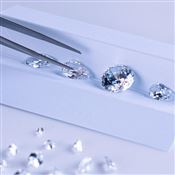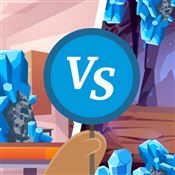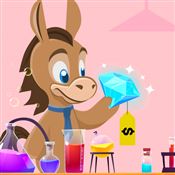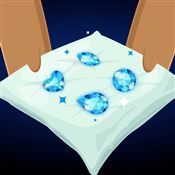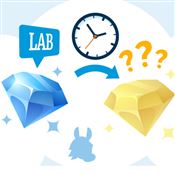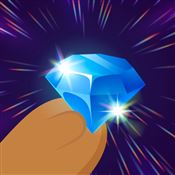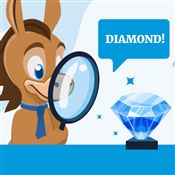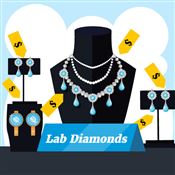Diamond Simulant
Diamond simulants can look exactly like diamonds. But are they real? Find out if these diamond alternatives are worth buying.
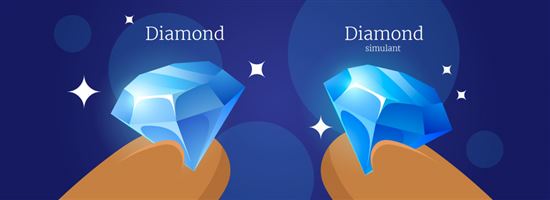 |
- What is a Diamond Simulant?
- What are Some Examples of Diamond Simulants?
- Simulated Diamonds vs. Real Diamonds
- How Much are Simulated Diamonds?
- Are Diamond Simulants the Same as Lab Diamonds?
- Best Diamond Simulant
- Are Simulated Diamonds Good Quality?
- Pros and Cons of Diamond Simulants
- Do Simulated Diamonds Pass a Diamond Tester?
- How can You Tell a Simulated Diamond?
Looking for sparkly stones that won't blind you with their price tag?
Diamond simulants resemble diamonds for a way cheaper price. But they have important differences you should consider before buying. Are they good quality? Will you regret buying them or are they worth it?
Learn about the characteristics of different diamond simulants. See how they compare with real diamonds. And decide if they're the right stones for you.
What is a Diamond Simulant?
Diamond simulants are stones that look like diamonds and have different properties.
When someone says "fake diamonds," they're most likely referring to diamond simulants.
They can appear just as white and sparkly. But these stones are not made of carbon and are thus not real diamonds. That's why they are cheaper and easily detected by jewelers and diamond testers.
What are Some Examples of Diamond Simulants?
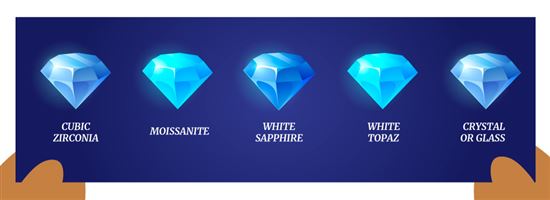 |
Any stone that's not made of carbon but looks like a diamond can be a simulant. The most popular ones are made inside laboratories. But there are also some that form naturally. Each is made of different materials and has its own unique qualities.
Below are some of the most common diamond simulants. Before diving deeper into their traits, let's first look at this table summarizing their properties.
| Composition | Hardness | Refractive Index | |
|---|---|---|---|
| Diamond | Carbon | 10 | 2.41 |
| Cubic zirconia | Zirconium oxide | 8.5 | 2.15-2.18 |
| Moissanite | Silicon carbide | 9.25 | 2.65 |
| White sapphire | Corundum | 9 | 1.77 |
| White topaz | Fluorine and aluminum | 8 | 1.61 |
| Crystal or glass | Silicon oxide and lead | 6-7 | 1.5-1.7 |
1. Cubic Zirconia
Cubic zirconias (CZs) are man-made stones composed of zirconium oxide. Because they're always flawless, these stones look like perfect diamonds. But they give off intense rainbow sparkles, whereas diamonds also emit white brilliance.
The main advantage of cubic zirconia is that it's super cheap but looks like a diamond.
At 8.5 on the Mohs scale, it's still relatively durable enough for daily wear. They're great for couples on very tight budgets.
Cubic zirconia can still get scratched up and become cloudy. They can also chip if hit in the right way. You may need to replace your stone every few years.
2. Moissanite
Moissanites are white natural gemstones discovered in a meteorite. But natural moissanite is super rare. Most moissanite today is man-made from silicon carbide.
Moissanites are popular for their durability at a more affordable price. Ranking 9.25 on the Mohs scale, they're close to a diamond's perfect 10. So for around $400 for 1 carat, you get a stone almost as durable as a diamond.
Because they reflect very intense rainbow sparkles, moissanite is a very flashy stone. It's the only simulant with a higher refractive index than diamonds. This can be a draw or turn-off, depending on taste.
3. White Sapphire
White sapphires are made of corundum and can be natural or manmade. Like moissanite, they're another durable yet cheaper alternative to diamonds. At 9 on the Mohs scale, they're another stone that can withstand everyday wear at $500 for a 1 carat stone.
But compared to diamonds, white sapphires look milky and less shiny. The sparkles they emit are silvery-gray, unlike the rainbow sparkles found in diamonds and other simulants.
4. White Topaz
The white form of topaz is another cheap alternative to diamonds. Most white topaz are natural, but they can also be man-made.
A carat retails for around $5, but they're also sold wholesale for even lower prices.
Many white topazes appear cloudy. Measuring 8 on the Mohs scale, they scratch even more easily than cubic zirconia.[2] So expect their sparkle won't last long due to scratches.
5. Crystal or Glass
Glass beads are made from a mixture of silicon oxide and lead. Of the simulants listed here, glass beads scratch the easiest. They rank 6-7 on the Mohs scale, so they're not very suitable for daily wear.
Glass beads are not as sparkly and can even have bubbles inside them. They have very low value and are sold per piece.
Swarovski crystals can be very beautiful, but they are actually glass beads. They have higher quality cutting and polishing to make the "stones" sparkle. They can be good for budget jewelry. But not for an engagement ring, since they'll scratch.
Simulated Diamonds vs. Real Diamonds
Price is the biggest difference between real diamonds and their simulants. You will save hundreds or even thousands when you switch to a simulant of the same size.
Simulants are good at mimicking how diamonds look. So based on appearance alone, the average person may find it hard to tell real diamonds from alternatives. While they have differences in sparkle and clarity, most people won't usually notice them.
The durability of different simulants varies. Some can last just as long as diamonds. But others will eventually scratch and lose their sparkle after a few years.
How Much are Simulated Diamonds?
Simulants differ in their price. But they're all very cheap compared to both natural and lab-grown diamonds.
The table below compares the prices of natural diamonds, lab diamonds, moissanite, and white sapphires. All stones are round and have similar qualities.
| Natural Diamond | Lab Diamond | Moissanite | White Sapphire | |
|---|---|---|---|---|
| 0.70 carat | $2,190 | $880 | $329 | $396 |
| 1 carat | $5,140 | $1,530 | $399 | $513 |
| 2 carat | $18,550 | $3,730 | $1,154 | $1,500 |
| 3 carat | $29,980 | $5,340 | $1,599 | $2,688 |
This table excludes cubic zirconia, white topaz, and glass. Since they can be bought for less than $20.
As the table shows, white sapphires and moissanite cost just a fraction of real diamonds. Opting for these alternatives can save you 70%-90% compared to natural and lab-grown diamonds.
Are Diamond Simulants the Same as Lab Diamonds?
Diamond simulants and lab diamonds are not the same.
While lab diamonds have the exact same properties as natural diamonds, simulants do not. As a result, diamond simulants and lab diamonds often have big differences in price and durability. It's important not to confuse them to avoid getting scammed.
If you're considering lab-grown diamonds, explore the best places to buy lab-grown diamonds to ensure you're purchasing from a trustworthy retailer.
Best Diamond Simulant
Moissanite is the best diamond simulant because of its durability and near identical look to diamonds. For a fraction of a diamond's price, you get a stone that can last just as long.
While they're way flashier, casual observers still can't tell moissanite from a diamond. Some who can spot moissanite even prefer it for its intense sparkle.
Are Simulated Diamonds Good Quality?
Simulated diamonds can be just as white and sparkly as real diamonds. Because most simulants are made in controlled conditions, they can even be better than natural diamonds in clarity and color.
Some simulants, particularly moissanite, can also last forever like a diamond.
Pros and Cons of Diamond Simulants
While simulants aren't real diamonds, buying them isn't a bad thing. There are pros and cons to opting for a diamond alternative.
Pros
- Affordable. They're way cheaper compared to real diamonds. With a simulant, you can get a bigger stone and a better setting with your budget. You can even combine them with diamonds for a better design.
- Higher quality. Compared to diamonds that vary in quality, the most common simulants are always flawless. You may also like the intense sparkles that some of them reflect.
- Ethical. Popular simulants, like moissanite and CZs, are lab-grown. Because they skip the mines, they're considered more ethical and sustainable choices.
Cons
- Durability. While some simulants are just as durable as diamonds, others may chip and scratch after a few years. It may cost you money and effort to maintain them.
- No resale value. Both real diamonds and their simulants have weak resale value. But it's worse for the alternatives since they aren't treated as special as diamonds.
- They're not "real." Some people may just prefer a diamond solely for its sentimental value.
Do Simulated Diamonds Pass a Diamond Tester?
Diamond simulants won't test as real. Because they don't have the same properties as real diamonds.
An exception is moissanite. These stones have similar thermal conductivity as diamonds. They can pass a thermal tester. To detect them, jewelers must use a multi-tester to also check the stone's electrical conductivity.
How can You Tell a Simulated Diamond?
Correctly identifying a stone is important to prevent rip-offs. However, it might be difficult to tell a simulant given how similar it looks to a real diamond.
But it's still possible to spot diamond simulants through some telltale signs.
- Price. Excellent, eye-clean lab diamonds don't usually go below $1,000 for one carat. If you're being sold a similar quality stone for a cheaper price, it's likely a simulant.
- Certificate. Diamond simulants don't usually come with certificates. But real diamonds always should. It's best to assume that the stone isn't a real diamond if the seller can't show you a certificate.
- Optical properties. Discerning eyes can spot optical differences between simulants and diamonds. For example, double refraction, cloudiness, and intense sparkle are signs that the stone is not a diamond. However, you may only be able to tell if you actually have a real diamond next to it.
- Diamond testers. Most diamond testers can detect all simulants except for moissanite. They're not foolproof indicators, but they're good starting points.
Bottom Line
Each type of diamond simulant has its own unique characteristics. Opting for a simulant instead of a real diamond will have its pros and cons.
Ultimately, deciding whether a diamond simulant is worth it will depend on your taste, budget, and priorities.
It's important to do thorough research and know what you want before making a decision.
References
- ^ The University of Texas at Austin. The Behavior of Light in Mineral and Gems: Refraction, Reflection, and the Critical Angle, Retrieved 8/02/2022
- ^ National Park Service. Mohs Hardness Scale, Retrieved 8/02/2022
- ^ ResearchGate. The Braganza diamond's conundrum, Retrieved 8/02/2022
Write to Chesca Santiago at feedback@creditdonkey.com. Follow us on Twitter and Facebook for our latest posts.
|
|
|
